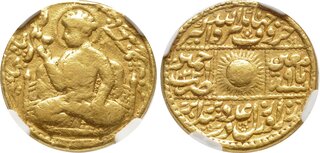| Classical Numismatic Group > Triton XXVII | Auction date: 9 January 2024 |
| Lot number: 1136 Price realized: 50,000 USD (Approx. 45,795 EUR) Note: Prices do not include buyer's fees. | Show similar lots on CoinArchives Find similar lots in upcoming auctions on |
| Lot description: INDIA, Mughal Empire. Nur al-Din Muhammad Jahangir. AH 1014-1037 / AD 1605-1627. AV Mohur (20mm, 10.81 g, 1h). So-called "Bacchanalian" type. Ajmer mint. Dually dated AH 1023 and RY 9 (11 February – 14/23 October AD 1614). shabih-e hazrat Shah Jahangir (The likeness of majesty Shah Jahangir) in Persian to left, qaza-e bar sikka zar kard tasvir (Destiny on gold coin did portray) in Persian to right, radiate Jahangir cross-legged left on ornate throne against patterned cushion holding flower or goblet / huruf-e Jahangir wah allahu Akbar (The letters of Jahangir and Allahu Akbar) in Persian above, za ruz awal dar a'dad shud brabar (from first day to last number becomes equal) in Persian below, central radiate sun within pelleted quadrate border with upper and lower lines extending to create additional side panels; zarb Ajmer (struck Ajmer) in Persian and AH date in left panel, mu'aiyan ba 9 sanat (equal to regnal year 9) in Persian and AH date in right. Liddle Type G-38; BM 319-21; IMC (Wright) –; Hull 1423-4; Zeno 161343 = Adams III, lot 2398 (same dies, but later die state); KM 179.6; Friedberg 76; Zeno 209176 = Album 32, lot 1866 (same dies). In NGC encapsulation 4660932-001, graded XF 40. Toned. Very rare portrait issue. Given that Jahangir was a celebrated patron of the arts, it is not surprising that he should have taken a strong interest in the coins struck during his reign. But this remarkable mohur represents an astonishing departure from established norms and conventions, and was clearly a source of controversy at the time. Not only does it bear the image of the emperor himself, but he is shown holding a wine-cup, and it is not hard to see why the devout might have felt sufficiently scandalized as to describe these portrait mohurs as 'Bacchanalian'. The obverse portrays Jahangir, seated cross-legged on his throne, nimbate and holding up a wine cup. In the center of the reverse is the radiant sun, said to represent the month of Jahangir's birth, with the mint and date to the left, and the regnal year to the right. Divided between obverse and reverse is a Persian couplet, engraved in calligraphy of the finest style, which was translated by Stanley Lane-Poole as: Destiny has drawn on money of gold The portrait of his Majesty Shah Jahangir The letters of Jahangir and Allahu Akbar Are equal in value from the beginning of time. According to Arabic numerology, the values of both Jahangar and Allahu Akbar are identical, with both equating to 292. Jahangir himself makes mention of this in his Memoirs, relating that he was told of this equivalence by a holy man who came to visit his court at Ajmer. 'Considering this a good omen,' Jahangir wrote, 'I gave the discoverer of this coincidence land, a horse, cash, and clothing.' While struck to the weight of standard currency mohurs, it seems clear that these beautiful coins were intended as presentation pieces. According to contemporary historical sources, Jahangir ordered that they were to be presented to favored ministers, servants and eminent visitors to the Mughal court. Jahangir's own courtiers and attendants were even instructed to wear these coins, prominently displayed on their clothing or on their turban sash, both as a mark of their status and also as a life-preserving amulet. Estimate: 50000 USD |  |



